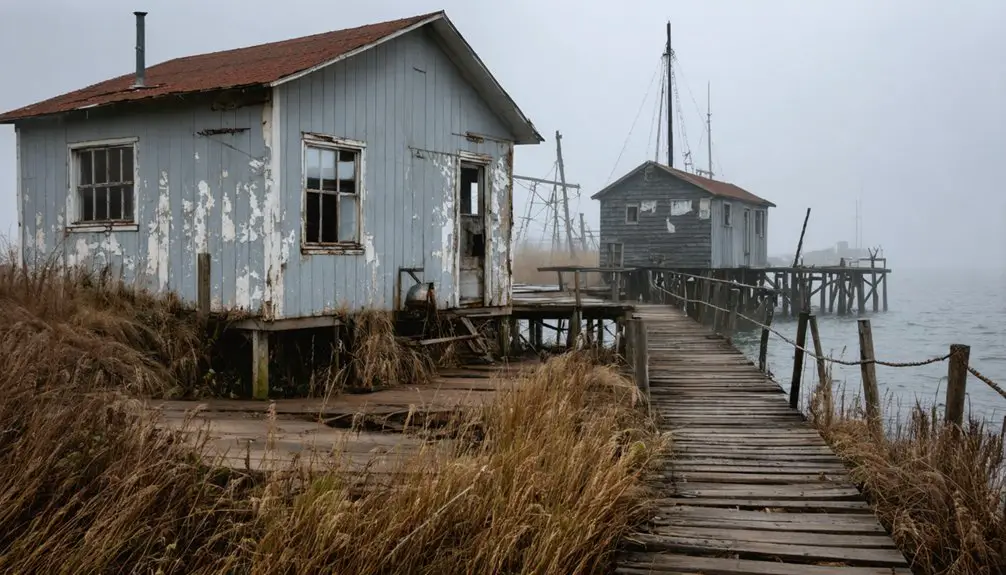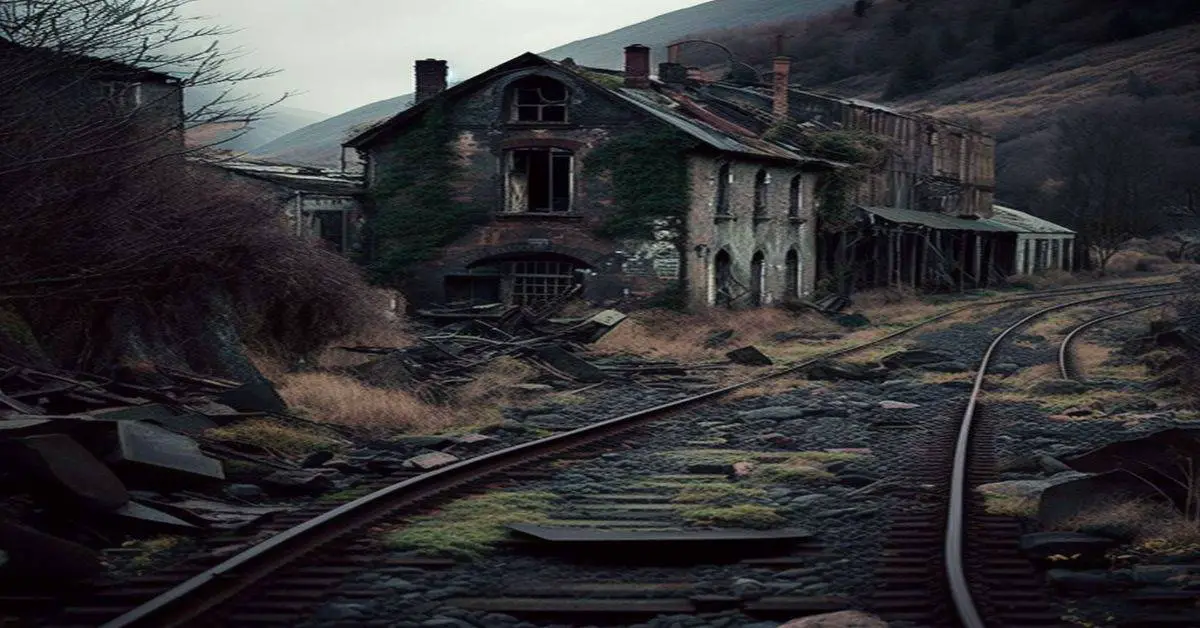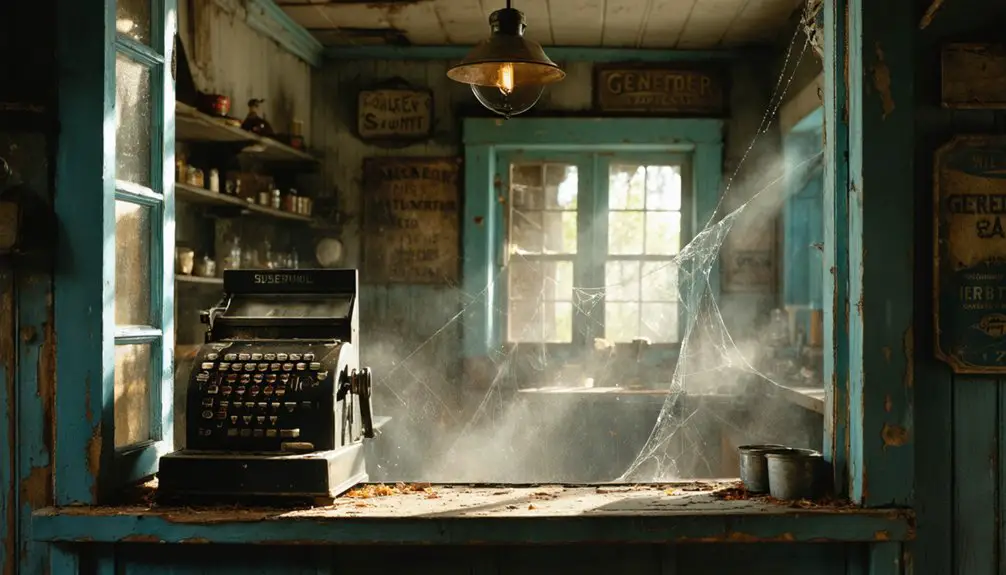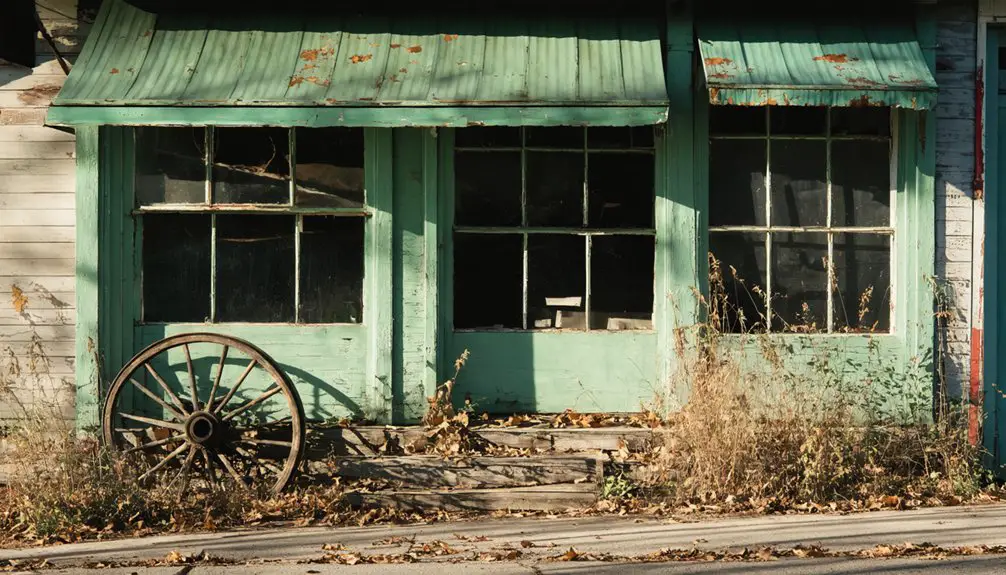You’ll find Basswood Island’s abandoned brownstone quarry among Lake Superior’s Apostle Islands, where a bustling community of 75 workers thrived from 1868 to 1893. The Bass Island Brownstone Company established a self-sufficient settlement with docks, buildings, and infrastructure to ship stone to eastern markets. Today, you can explore hiking trails leading to historic quarry ruins, stone walls, and abandoned cottages. The island’s silent monuments hold deeper stories of triumph and tragedy.
Key Takeaways
- Basswood Island’s abandoned brownstone quarry, established in 1868, remains a ghost town with visible ruins of industrial operations and worker settlements.
- The Christmas Eve blizzard of 1893 led to the quarry’s closure, leaving stone walls and ruined cottages as silent monuments.
- Over 75 workers once inhabited a self-sufficient settlement with docks, buildings, and infrastructure, now reduced to archaeological remains.
- Archaeological excavations in 1988 revealed over 5,000 years of human history through artifacts, foundations, and tools.
- Nature rapidly reclaims the ghost town structures through harsh freeze-thaw cycles, with forests engulfing abandoned buildings and quarry ruins.
The Rise of Basswood Island’s Quarry Community
While many Lake Superior communities grew around fishing or lumber, Basswood Island‘s development stemmed from its rich deposits of brownstone. In 1868, after extensive prospecting, the Bass Island Brownstone Company established the region’s first brownstone quarry on the island’s south end, transforming the remote location into a bustling work site. The hiking trails today still lead visitors to the historic quarry site.
The work was labor-intensive, with seventy-five employees typically staffing quarry operations when the site was active. You’ll find that quarry operations quickly shaped community dynamics, with workers and management creating a self-sufficient settlement complete with docks, buildings, and essential infrastructure.
The site’s strategic location near Chequamegon Bay, coupled with the new Bayfield railroad, enabled the quarry to ship its prized stone to eastern markets. The community thrived during the 1880s-1890s peak period, when the brownstone was in high demand for prestigious projects like the Milwaukee Courthouse.
Life in the McCloud-Brigham Farm Settlement
As Richard McCloud staked his homestead claim on Basswood Island in 1865, he laid the foundation for what would become one of the region’s most productive agricultural settlements. His innovative farming techniques yielded remarkable harvests, including giant pumpkins and diverse varieties of onions and corn that supplied the bustling quarry workforce nearby.
The settlement’s community dynamics shifted when the Brigham family took over in 1903, transforming the operation into a dual-purpose venture. They expanded the orchards with hundreds of apple and cherry trees while running a logging camp that housed up to 50 men. Modern researchers studying the settlement have benefited from the extensive Wisconsin Name Index that contains biographical records and obituaries of the area’s early settlers. The farm’s historic significance was recognized when its quarry was listed on Register of Historic Places.
The farm’s legacy lived on through newspaper accounts of its extraordinary produce and its essential role in sustaining island industries, from quarrying to logging, demonstrating the resourcefulness of these early settlers.
Tragic Tales From Christmas Eve 1893
You’ll find few stories more haunting from the Apostle Islands’ quarrying era than the Christmas Eve blizzard of 1893, when Dan McCrea’s wife and two neighbors became disoriented while crossing the frozen lake from Bayfield.
Though McCrea found the group less than a mile from safety, his wife died in his arms before reaching shore, and her death cast a shadow over Basswood Island’s quarry village.
The stone walls remain today as silent monuments to the quarrymen’s labor and sacrifice.
The tragedy’s impact lingered long after that winter night, contributing to the quarry’s closure and leaving behind only stone ruins as evidence to the harsh realities faced by these isolated island communities. Lake Superior’s treacherous waters, which the Ojibwe believed were protected by Mishi Peshu, had claimed yet another life.
Blizzard Claims Mrs. McCrea
On Christmas Eve 1893, a routine shopping trip to Bayfield turned tragic when a fierce Lake Superior blizzard claimed the life of Mrs. McCrea.
While crossing the frozen lake with two neighbors, the group became disoriented in blinding snow just three miles from their quarry village on Basswood Island.
As darkness fell and conditions worsened, Dan McCrea ventured out with lantern and compass to seek help in Bayfield.
Upon his return, he found the party near the island’s shore, but his wife had grown too weak to continue. She died in his arms, just short of safety.
The blizzard’s impact extended beyond that night – within a few years, the quarry closed permanently, leaving only stone walls and cottage ruins as silent witnesses to this haunting tale.
The Quarry Village’s End
While the Christmas Eve blizzard of 1893 marked a tragic turning point for Basswood Island’s quarry village, the settlement’s decline had deeper roots in the harsh realities of frontier industrial life.
You’ll find evidence of this struggle in the remaining stone walls and ruined cottages, where quarry labor once sustained a tough community of mostly Irish workers and their families.
Under the leadership of foreman Dean Monaghen, the quarrymen extracted valuable brown sandstone that supplied the Midwest’s growing construction industry.
The village’s isolation made winter survival particularly challenging, with workers facing not just the physical demands of stonecutting but also the perils of frozen lake crossings.
The park historian, Bob Math, has spent 30 years researching these historic sites and their stories within the Apostle Islands.
After Mrs. McRea’s death, the quarry’s eventual closure a few years later seemed almost inevitable.
Today, you can still explore these haunting remnants of a once-bustling industrial community, where every crumbling wall tells a story of hardship, resilience, and ultimate abandonment.
Lasting Impact On Community
The Christmas Eve blizzard of 1893 forever changed Basswood Island’s close-knit quarry community, leaving emotional scars that resonated long after Mrs. McCrea’s tragic death in her husband’s arms.
You’ll find this devastating event showcased the winter challenges these isolated pioneers faced, yet also highlighted their remarkable community resilience.
The Antelope wreck discovery near Michigan Island in 2016 revealed more tragic history of the treacherous waters surrounding the Apostle Islands.
The blizzard’s impact manifested in three distinct ways:
- It accelerated the quarry’s eventual closure
- It strengthened bonds between remaining families who relied on each other for survival
- It created lasting cultural folklore that still echoes through the Apostle Islands
Today, you can explore the stone ruins and cottage remnants while reflecting on the determination of these early settlers.
Their story, particularly Dan McCrea’s desperate search for his wife, continues to shape the region’s identity and serves as a powerful reminder of Lake Superior’s unforgiving nature.
Abandoned Structures and Their Stories
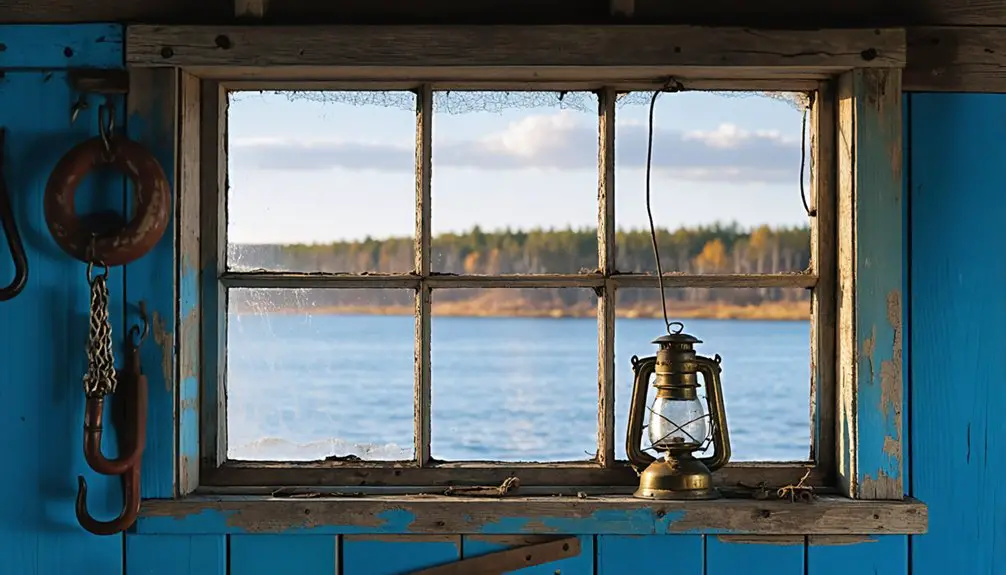
Scattered across the remote Apostle Islands, abandoned structures tell vivid stories of human ambition and perseverance in Lake Superior’s challenging environment.
You’ll find the weathered remains of the Bass Island Brownstone Quarry, established in 1868, where massive stone blocks were cut and shipped to build Milwaukee’s courthouse. The abandoned architecture includes crumbling docks, machinery foundations, and support buildings that once bustled with industrial activity.
Along the shorelines, you’ll discover lonely lightkeeper stations with their auxiliary buildings slowly surrendering to nature. In 1970, these historic sites gained protected status when Gaylord Nelson successfully established the Apostle Islands National Lakeshore.
These historically significant sites feature old fog signal buildings, boathouses, and keeper’s quarters that stand as silent witnesses to maritime history. Though many structures are deteriorating, they preserve the legacy of those who carved out lives on these isolated islands against the harsh elements of Lake Superior.
Mysterious Sightings and Local Legends
Within the mist-shrouded shores of the Apostle Islands, mysterious sightings and ghostly legends have captivated visitors for generations.
You’ll find tales of dark figures silently watching from Hermit Island, particularly the spectral form of William Wilson, a 19th-century recluse whose presence still lingers.
Local folklore weaves together three distinct sources of ghostly encounters:
- Lighthouse hauntings tied to isolated keepers and tragic deaths
- Indigenous Ojibwe spiritual traditions connecting natural features to supernatural guardians
- Tales of hidden pirate treasures protected by restless spirits
These stories often trace back to real historical hardships, like Mrs. McCrea’s death in an 1893 blizzard near Basswood Island.
The islands’ abandoned structures and quarry walls hold echoes of past struggles, creating an enduring legacy of unexplained phenomena that continues to intrigue modern explorers.
The Last Residents: Who They Were
During the late nineteenth century, life on the Apostle Islands centered around a fascinating mix of reclusive figures, industrious quarry workers, and enduring Native American leaders.
You’ll find the story of Joseph McCloud, a former judge who retreated to Basswood Island with his pump organ, living as a hermit until his death in 1900.
Dan McCrea and his quarry workers carved out a community there, with families occupying small cottages near the bustling stone operation.
On Madeline Island, indigenous leaders like Chief Buffalo (Kechewaishke) and Madeline Equasayway Cadotte shaped the region’s destiny through diplomatic prowess and cultural preservation.
Chief Buffalo and Madeline Cadotte’s leadership on Madeline Island wove indigenous wisdom into the fabric of Great Lakes history.
While most islands became uninhabited after the quarry’s closure in the early 1900s, Madeline Island remains the only year-round populated island, maintaining its sacred significance to the Ojibwe people.
Nature’s Reclamation of Historical Sites
As Lake Superior’s fierce climate batters the Apostle Islands, nature steadily reclaims the remnants of human settlement through an intricate dance of vegetation, weathering, and wildlife.
You’ll find ecological balance returning as forests engulf abandoned structures, while native plants like wild rice and blueberries flourish around historical ruins.
The lake’s relentless forces accelerate this transformation in three distinct ways:
- Harsh freeze-thaw cycles break down remaining structures
- Cold winds and moisture patterns foster aggressive plant growth
- Seasonal storms reshape the physical landscape
Wildlife has enthusiastically recolonized these spaces – birds nest in crumbling walls, mammals den in overgrown foundations, and new habitats emerge where humans once dwelled.
Though stone walls and sandstone foundations endure, they’re slowly disappearing beneath nature’s persistent advance.
Archaeological Discoveries and Artifacts
The Midwest Archaeological Center‘s 1988 excavations revealed a rich tapestry of human history beneath the reclaimed wilderness of the Apostle Islands.
You’ll find archaeological significance spanning over 5,000 years, from prehistoric remains to 20th-century settlements. The excavations uncovered foundations, household items, and tools that tell stories of the region’s industrial past.
Excavated artifacts reveal millennia of human activity, from ancient settlements to industrial ruins, each layer telling unique stories of the past.
Through artifact analysis, you can trace the lives of quarry workers, fishermen, and lighthouse keepers who once called these islands home.
You’ll discover evidence of stone quarrying on Basswood Island, fishing equipment scattered across various sites, and domestic items that paint a picture of daily life.
The archaeological record extends underwater too, where roughly 700 shipwrecks add another layer to the islands’ maritime heritage, offering glimpses into transportation and trade networks of the past.
Preserving the Memory of Lost Communities
While modern visitors explore the quiet shores of the Apostle Islands, dedicated preservation efforts guarantee that memories of its lost communities endure. Through coordinated preservation strategies between local historical societies and the state preservation office, you’ll find carefully maintained sites that tell the story of these vanished settlements.
Community involvement remains essential to protecting these historical treasures through:
- Educational programs teaching local school children about their maritime heritage
- Volunteer-led cemetery restoration projects that honor former residents
- Historical marker installations and interpretive trails that guide visitors through significant locations
You can explore well-documented sites where archival photographs, maps, and oral histories from descendants paint a vivid picture of life in these former island communities.
These preservation efforts assure future generations will understand the region’s rich cultural past.
Frequently Asked Questions
What Was the Average Salary of Quarry Workers in the 1800S?
You’d find quarry worker wages in the 1800s labor market ranged from 40 to 63 cents per day, translating to roughly $12 monthly, though your exact pay depended on skill level and location.
Are There Any Documented Deaths Besides Mrs. Mccrea at Basswood Island?
While local legends hint at unexplained phenomena, you’ll find no officially documented deaths on Basswood Island besides Mrs. McCrea’s tragic 1893 blizzard incident, though nearby islands saw quarry worker fatalities.
When Was the Last Permanent Resident Recorded Living in These Settlements?
You’ll find the last residents stayed on Madeline Island, where about 500 people still live today. Other settlements saw their permanent populations fade in the early-to-mid 1900s during industrial decline.
Did Native Americans Use the Abandoned Buildings After Settlers Left?
You won’t find concrete evidence of Native American usage of abandoned structures – while the Ojibwe maintained cultural ties to the area, they didn’t greatly repurpose settler buildings after settlements were abandoned.
What Happened to the Quarry Equipment When Operations Suddenly Ceased?
Like abandoned soldiers on a battlefield, your quarry equipment simply remained where it stood after operational cessation in the 1890s, rusting away due to harsh weather and limited transport options.
References
- https://www.apostleisland.com/2021/07/29/the-apostle-islands-centuries-of-stories/
- https://www.bobmackreth.com/apisghosts.html
- https://ladycationsnet.wordpress.com/2018/10/07/madeline-island-a-brief-history-of-wisconsins-secret-paradise/
- https://www.youtube.com/watch?v=NLK3xhLeVCk
- http://sites.rootsweb.com/~witttp/apostleislands.htm
- https://www.bayfieldheritage.org/stone-quarries-of-the-apostle-islands/
- https://en.wikipedia.org/wiki/Basswood_Island
- https://www.nps.gov/places/basswood-island-apis.htm
- https://www.bayfield.org/plan-your-visit/our-history/brownstone-quarrying/
- https://www.wisconsinhistory.org/Records/Image/IM49108
